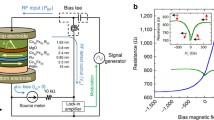Abstract
The use of the spin-torque diode effect, which is generated upon the current-induced transfer of spin angular momentum in magnetic tunnel junctions, opens the prospect of considerably improving microwave sensitivity in the gigahertz frequency band over that of semiconductor Schottky diodes. In this work, the spin-diode effect of microwave signal rectification in a magnetic tunnel junction upon the resonant excitation of spin waves in the free magnetic layer as a result of the current-induced spin-transfer torque effect is analyzed theoretically. Frequency characteristics of the resonant response of a spin-torque diode to a microwave signal are calculated in the linear macrospin approximation as functions of the direction and value of the applied magnetic field and bias current. It is shown that with zero bias current, the maximum rectified voltage across a junction is obtained in the geometry of mutually perpendicular magnetizations of magnetic layers; as the resonant frequency of oscillations in a magnetic field increases, this voltage drops at the retained equilibrium orientation of spins in the layers. After the bias current is switched on, the resonance amplitude of forced oscillations of the free layer spins upon microwave excitation grows sharply at the critical point of the spin-torque diode’s loss of equilibrium state stability. The linewidth at this point is limited only by nonlinear effects. Improving spin-torque diode sensitivity is important for its use in microwave holographic vision systems.






Similar content being viewed by others
REFERENCES
A. A. Tulapurkar, Y. Suzuki, A. Fukushima, et al., Nature (London, U.K.) 438, 339 (2005).
S. Miwa, S. Ishibashi, H. Tomita, et al., Nat. Mater. 13, 50 (2014).
T. Zeng, Y. Zhou, K. W. Lin, et al., IEEE Trans. Magn. 51, 1401204 (2015).
L. Fu, Y. S. Gui, L. H. Bai, et al., J. Appl. Phys. 117, 213902 (2015).
C. Wang, Y. T. Cui, J. Z. Sun, et al., J. Appl. Phys. 106, 053905 (2009).
J. Zhu, J. A. Katine, G. E. Rowlands, et al., Phys. Rev. Lett. 108, 197203 (2012).
S. Hemour, Y. Zhao, C. H. P. Lorenz, et al., IEEE Trans. Microwave Theory Technol. 62, 965 (2012).
A. F. Popkov, N. E. Kulagin, and G. D. Demin, Solid State Commun. 248, 140 (2016).
Z. H. Zhang, Y. S. Gui, L. Fu, et al., Phys. Rev. Lett. 109, 037206 (2012).
Y. S. Gui, Y. Xiao, L. H. Bai, et al., Appl. Phys. Lett. 106, 152403 (2015).
ACKNOWLEDGMENTS
This work was supported by the Russian Science Foundation, project no. 16-19-00181.
Author information
Authors and Affiliations
Corresponding author
Additional information
Translated by E. Bondareva
Rights and permissions
About this article
Cite this article
Popkov, A.F., Kulagin, N.E., Demin, G.D. et al. Field Characteristics of Spin-Torque Diode Sensitivity in the Presence of a Bias Current. Semiconductors 52, 1909–1914 (2018). https://doi.org/10.1134/S1063782618150101
Received:
Accepted:
Published:
Issue Date:
DOI: https://doi.org/10.1134/S1063782618150101




